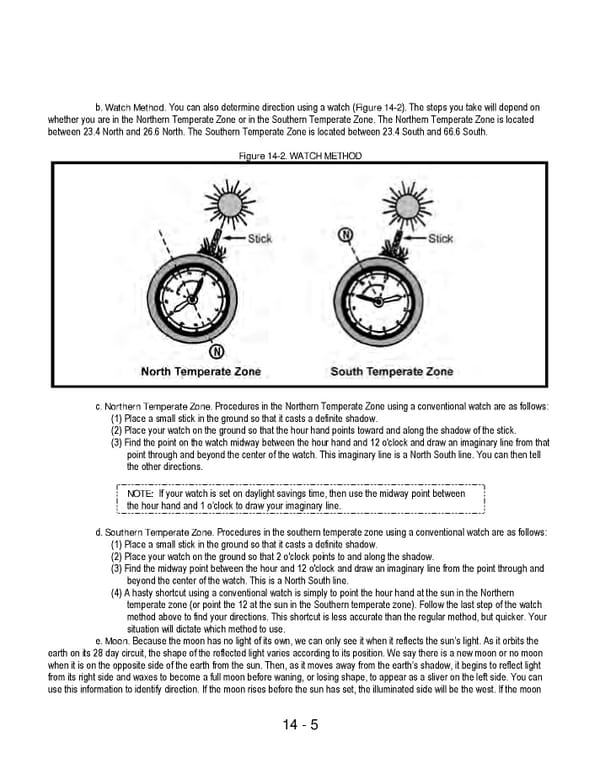14 - 5 b. Watch Method. You can also determine direction using a watch (Figure 14-2). The steps you take will depend on whether you are in the Northern Temperate Zone or in the Southern Temperate Zone. The Northern Temperate Zone is located between 23.4 North and 26.6 North. The Southern Temperate Zone is located between 23.4 South and 66.6 South. Figure 14-2. WATCH METHOD c. Northern Temperate Zone. Procedures in the Northern Temperate Zone using a conventional watch are as follows: (1) Place a small stick in the ground so that it casts a definite shadow. (2) Place your watch on the ground so that the hour hand points toward and along the shadow of the stick. (3) Find the point on the watch midway between the hour hand and 12 o'clock and draw an imaginary line from that point through and beyond the center of the watch. This imaginary line is a North South line. You can then tell the other directions. NOTE: If your watch is set on daylight savings time, then use the midway point between the hour hand and 1 o’clock to draw your imaginary line. d. Southern Temperate Zone. Procedures in the southern temperate zone using a conventional watch are as follows: (1) Place a small stick in the ground so that it casts a definite shadow. (2) Place your watch on the ground so that 2 o'clock points to and along the shadow. (3) Find the midway point between the hour and 12 o'clock and draw an imaginary line from the point through and beyond the center of the watch. This is a North South line. (4) A hasty shortcut using a conventional watch is simply to point the hour hand at the sun in the Northern temperate zone (or point the 12 at the sun in the Southern temperate zone). Follow the last step of the watch method above to find your directions. This shortcut is less accurate than the regular method, but quicker. Your situation will dictate which method to use. e. Moon. Because the moon has no light of its own, we can only see it when it reflects the sun’s light. As it orbits the earth on its 28 day circuit, the shape of the reflected light varies according to its position. We say there is a new moon or no moon when it is on the opposite side of the earth from the sun. Then, as it moves away from the earth’s shadow, it begins to reflect light from its right side and waxes to become a full moon before waning, or losing shape, to appear as a sliver on the left side. You can use this information to identify direction. If the moon rises before the sun has set, the illuminated side will be the west. If the moon
 Ranger Handbook Page 252 Page 254
Ranger Handbook Page 252 Page 254